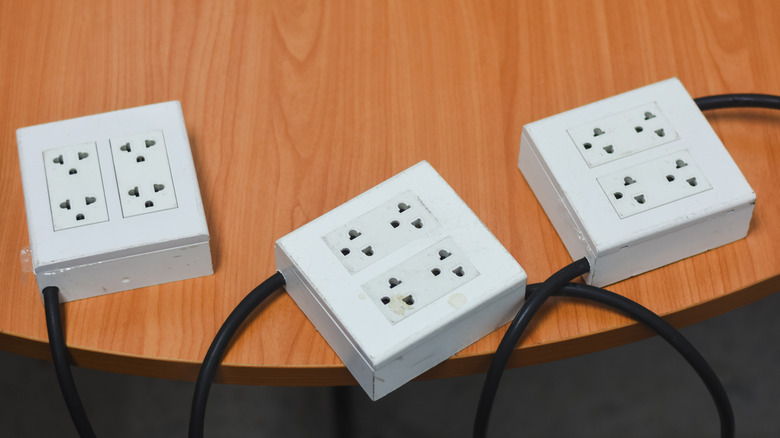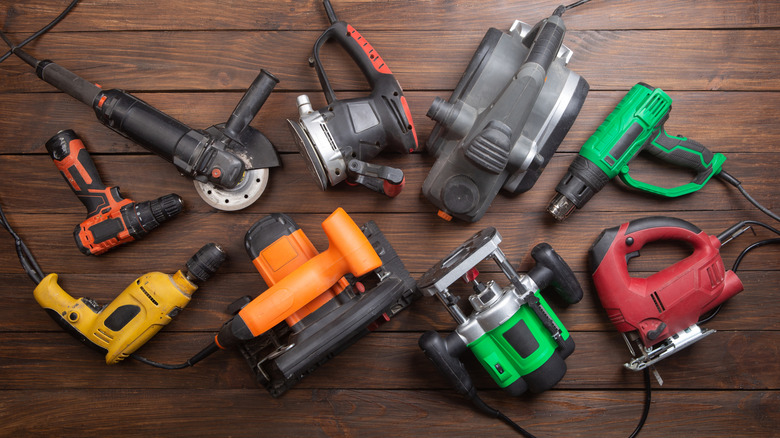Never Plug These Devices Into Extension Cords Or Power Strips
With the ever-increasing number of electronic devices in our households, we are almost always looking for power outlets, either to charge our iPhones, connect computer peripherals, plug in tools, or for numerous other reasons. However, most times, outlets are either too far away or in short supply. That's why extension cords and power strips have emerged as two of the most useful household accessories, and are very popular at stores like Harbor Freight and Ikea.
Despite their benefits in terms of convenience and mobility, extension cords and power strips aren't the best solution for every kind of electronic device. Both accessories are designed to handle a specific load capacity and have a limited lifespan. If you overload them or continue using them despite them getting pretty old, you essentially make them fire hazards. According to the U.S. Fire Administration (USFA), there were over 23,000 residential fires caused by electrical malfunctions in 2023 alone. So, if you don't want a melted extension cord or power strip, or worse, a visit from the fire department, it's best to never plug the following devices into them.
High-wattage kitchen gadgets
Kitchen essentials, such as electric grills, microwaves, toaster ovens, or even the best-rated air fryers, are a strict "no," as they can exceed the load capacity of a typical extension cable or power strip (around 1,800W) because they need a lot of power to produce the heat required for their operation. The overloading can cause overheating, melting, or even an electrical fire in the worst-case scenario if the power strip or the extension cable doesn't feature built-in load protection.
Similarly, while the typical operational power draw of freezers, refrigerators, and other devices with a compressor isn't a lot, they can draw a large surge of power during startups, which can overload a power bar and potentially cause issues. So, it's best to plug any high-wattage gadgets or appliances with compressors directly into a wall outlet. Even if one may work when connected to an outlet strip, there is no point in risking the safety of your home.
Another power strip or extension cable
Plugging a power strip into another power strip, also known as daisy-chaining, is a bad idea and a violation of NFPA's fire safety code. It can result in circuit overheating and quickly become a fire hazard. So, it's best to remove a device from your existing power strip to plug in something new, or plug the new power strip into another outlet if you need to connect more appliances.
The same goes for extension cables, as you risk increasing the wire resistance by extending the length of the total connection. There is also potential for a loose connection over time and voltage drop at the final outlet, which can cause connected devices to draw more current and overheat the cable. The reduction in voltage because of the use of multiple extension cables can also be harmful to the electronic components of the connected device. Your best option is to buy an extra-long extension cable that's rated to meet your needs.
Power tools and critical medical equipment
Power tools, such as drills, saws, and grinders, are another set of devices that are best avoided connecting to an extension cable or a power bar. Some of these tools simply have a high load rating, whereas others with motors can generate power surges that can overload your extension cable or power strip. So, if you don't want to risk turning your workspace or garage into a fire hazard, stick to proper wall outlets while connecting a power tool.
While medical equipment like CPAP machines may not overload your power strip or extension cable, they still need a reliable and stable power source, and are designed to work within specific voltage and current parameters. By introducing an extension cable or power bar in the connection of medical equipment, you may be adding a failure point that can have significant consequences. Poor-quality power strips can cause a voltage drop, resulting in inaccurate readings or device malfunctions. Many power strips also have built-in circuit breakers that trip the connection in case of overloading, which can potentially result in the medical equipment getting turned off when it should be running. If you really need to use a power strip, it's best to invest in a hospital-grade power strip that has the necessary protections.



